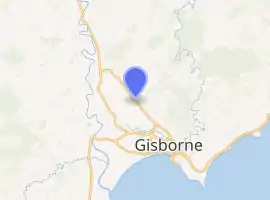Hexton, New Zealand
Hexton or Manakauri is a village and rural area in the Gisborne District of New Zealand's North Island. It is located north-west of Gisborne City,[2] and includes the settlements of Makauri and Waerengaahika.[3][4]
Hexton | |
|---|---|
Settlement | |

| |
| Coordinates: | |
| Country | New Zealand |
| Territorial authority | Gisborne District |
| Ward | Taruheru Patutahi |
| Population (2018)[1] | |
| • Total | 2,946 |
| Postcode(s) | 4071 |
The fertile plain east of the Waipaoa River was settled by the 19th century by families of Hampshire in southern England, with assistance from the New Zealand Government. The de Latour family named the area after their English village of Hexton.[5]
The Chitty Family began growing wine in the area during the 1930s and 1940s, becoming one of three dominant families in Gisborne's early wine industry.[6]
Demographics
| Year | Pop. | ±% p.a. |
|---|---|---|
| 2006 | 2,496 | — |
| 2013 | 2,688 | +1.06% |
| 2018 | 2,946 | +1.85% |
| Source: [1] | ||
The statistical area of Hexton, which covers 120 square kilometres and also includes Waihirere, had a population of 2,946 at the 2018 New Zealand census, an increase of 258 people (9.6%) since the 2013 census, and an increase of 450 people (18.0%) since the 2006 census. There were 1,035 households. There were 1,506 males and 1,440 females, giving a sex ratio of 1.05 males per female. The median age was 44.2 years (compared with 37.4 years nationally), with 615 people (20.9%) aged under 15 years, 441 (15.0%) aged 15 to 29, 1,413 (48.0%) aged 30 to 64, and 477 (16.2%) aged 65 or older.
Ethnicities were 85.4% European/Pākehā, 21.8% Māori, 1.5% Pacific peoples, 1.9% Asian, and 2.0% other ethnicities (totals add to more than 100% since people could identify with multiple ethnicities).
The proportion of people born overseas was 10.9%, compared with 27.1% nationally.
Although some people objected to giving their religion, 51.1% had no religion, 38.5% were Christian, 0.1% were Muslim, 0.2% were Buddhist and 2.4% had other religions.
Of those at least 15 years old, 438 (18.8%) people had a bachelor or higher degree, and 405 (17.4%) people had no formal qualifications. The median income was $37,500, compared with $31,800 nationally. The employment status of those at least 15 was that 1,281 (55.0%) people were employed full-time, 477 (20.5%) were part-time, and 42 (1.8%) were unemployed.[1]
Marae
Tarere Marae and Te Aotipu meeting house is a meeting place of the hapū of Te Whānau a Iwi.[7][8]
Education
Makauri School is a Year 1–6 co-educational public primary school[9] with a roll of 170 as of March 2020.[10][11][12]
References
- "Statistical area 1 dataset for 2018 Census". Statistics New Zealand. March 2020. Hexton (205400). 2018 Census place summary: Hexton
- Hariss, Gavin. "Hexton, Gisborne". topomap.co.nz. NZ Topo Map.
- Hariss, Gavin. "Waerengaahika, Gisborne". topomap.co.nz. NZ Topo Map.
- Hariss, Gavin. "Waerengaahika, Gisborne". topomap.co.nz. NZ Topo Map.
- "Hexton". nzhistory.govt.nz. Ministry for Culture and Heritage.
- "Gisborne Wine History". gisborne.co.nz. gisborne Ltd.
- "Te Kāhui Māngai directory". tkm.govt.nz. Te Puni Kōkiri.
- "Māori Maps". maorimaps.com. Te Potiki National Trust.
- "Official School Website". makauri.school.nz.
- "New Zealand Schools Directory". New Zealand Ministry of Education. Retrieved 26 April 2020.
- "Ministry of Education School Profile". educationcounts.govt.nz. Ministry of Education.
- "Education Review Office Report". ero.govt.nz. Education Review Office.